Tricks of the Mind
The tricks your mind plays on you are up for analysis this week as we explore the science of taste including why noise diminishes food flavour aboard an aeroplane and how much affects your choice of wine. We also speak to a synaesthete who, quite literally, tastes the people he meets, and we probe the workings of the placebo effect. Plus, pain killers from black mamba venom, why teenagers take risks and the age old chestnut of why names are so hard to remember...
In this episode

01:29 - The Science of Taste I
The Science of Taste I
with Barry Smith, University of London
Chris - Now most people regard taste as a very simple sense. You put something in your mouth and your tongue tells you the flavour, right or wrong? Well not quite because it turns out that how you perceive taste is a very intricate and complicated relationship that combines several different senses. Apart from just your tongue's taste buds, food texture, smell, sight, and even the sounds around you affect an eating experience. And to explain exactly how, with us is Professor Barry Smith from the University of London. Hello, Barry.
Barry - Hello.
Chris - So, begin by taking us on a flavour trip if you like, of what actually happens when we eat something.
Barry - Well, as you just said, people think they're getting most of the experience of flavour from their tongue, but in fact, the tongue gives you very little. It just gives you salt, sweet, sour, bitter, savoury, now we think metallic as well. You can taste blood in your mouth, that metal taste. But think of all the things that you are used to experiencing. You can taste strawberry or onion, or melon, or cinnamon, and we don't have receptors for those. So that tells you that you're getting it from somewhere else and most of it is coming from smell. But as well as smell, you've also got touch. That's the creaminess of something in the mouth, there's how stale it is if it crumbles rather differently. But think of something like pepper. We like to put black pepper on our food, but we don't have taste receptors for paper. In fact, what that is doing is irritating the trigeminal nerve and it's the one that becomes very sore at the bridge of the nose. It starts to sort of ring bells and be stingy when your mustard is too hot.
Chris - Horseradish...
Barry - Horseradish, right and it also makes peppermint or spearmint taste cool in the mouth even though there's no temperature change at all. So you have at least got touch, taste and smell combining always to give you what you get as flavour.
Chris - So, when we put something in there, the heat from your mouth imparts some energy to the molecules of food you've put in, so some of them are going to drift off and go up your nose up the back of your throat then and so, you'll get this retro aroma experience.
Barry - Actually, you have 2 senses of smell - so you can smell something externally from the environment and then when you put something in your mouth, and those volatiles go up through the nasal pharynx and start to activate the very same receptors in the nose, you will maybe get a very different experience. So, the brain pays attention to the difference between airflow coming in or going out, coming from the mouth or coming from the world. So, think of a smelly chess like epoisses. It smells really rather disgusting and yet, when you put it in your mouth, delicious, lovely. And that shows you the aroma is behaving differently depending on direction of flow.
Chris - A relative of mine said to me the other day - there was one cheese that he did actually have to throw away. He bought some stinking bishop and he said, "I could not bring myself to eat it."
Barry - But if he had, maybe...
Chris - But it tastes fantastic, doesn't it?
Barry - Yeah, exactly.
Chris - Why is that then, why do we get this very nauseating affront when you open the packet and you think, "Am I really going to put that in my mouth?" But then when it goes in, it is actually gorgeous.
Barry - Well, it is because of the difference between the way the very same odours are treated, depending on whether they came retronasaly from the mouth or orthonasaly from the nose. And there's another way in which they can mismatch. Think of coffee. A smell of freshly brewed coffee is wonderful, but aren't yours just a little disappointed that the taste in your mouth is not quite the same?
Chris - It's certainly a disparity. That's true.
Barry - Yeah, it is a disparity, but there's one food where we have exactly the same sniffing from the outside and experiencing from the inside, and that's chocolate. And that's probably why it's a wonder food because you get what you expect, and you're very satisfied
Chris - To think about chocolate is that it does fulfil or tick all those boxes that you mentioned isn't it because you have the texture. It melts in the mouth, so it changes from being something hard with that rough texture into something smooth, that easily glides over your tongue. It's got an intense sugar punch that it packs, the same for fat. So there's all those experiences plus those aromas going at the back of your throat.
Barry - Yeah, I think everything as you said ticks all the boxes. And also, you'll notice when you're eating chocolate truffles, so full of butter that the very smooth feel actually bluffs the brain into thinking there's something cool and sensuous in the mouth, and actually because it's rubbing the somatosensory receptors in a slightly different way. It's more like being stroked than being rubbed.
Chris - Well, they do say that chocolate does play a part in love and that kind of thing, don't they? What about actually using that knowledge then? Are food manufacturers are saying, "Well, we know how chocolate does it and we know it's irresistible." So, can we confer that experience on other things so that people will embrace a pot noodle even, something like that with the same lure as in the same alacrity as a chocolate bar?
Barry - Well, that's right. I mean, people in the food industry know this stuff very well and they know that say, the creaminess of something can affect how sweet it tastes. So perhaps you can put less sugar in by making something taste creamier. And equally, when you've got low fat yogurts, people didn't want to eat them because they thought they just don't have that substance to them. So, if you can have something which is still giving you the same stroking, the same feeling, maybe that will slightly improve the flavour of what you're eating, although we do, I think now believe there are fat receptors in the mouth or at least fatty acid receptors. So, the brain is only bluffed so long and then eventually, it wants the real fat content.
Chris - What about sound? Because there was a study I read a number of years ago where I don't know if this is apocryphal or if it's true - a supermarket playing different music in the wine section felt they could influence people's choices of wine. People are presumably imagining what that wine would taste like in the context of that music, which is why they were changing their minds about what they wanted to buy when they played French music or Italian music.
Barry - They didn't even have to imagine. I mean, the beautiful thing in this study was that you had Oom-pa-pa German music and French accordion music, and the percentage of French and German wine varied according to the time at which different music was played. But when you ask people on the checkout, "Why did you buy this wine?" "Oh! I just thought this would be a nice thing to drink." "Was it the music that influenced you?" "What music?" So, sound can have a big clue, but the best sound effect on flavours actually, collaborator and friend of mine, the psychologist Charles Spence who works on this, he won the Ig Nobel Prize for his work on potato chips. So, if you leave them out for a couple of days and they go stale, you put them in your mouth, not so fresh, but if you put headphones on people, and you amplify the high frequency sound of their own crunching back to them, the crisps tastes fresh.
Chris - Oh wow! So you get people to eat them and play the sounds back, and they say that the crisps are fresh. They can't tell that they're stale.
Barry - They can't tell that they're stale which shows you and he wants to know whether that makes tasting stale more of a sound experience than a taste experience. It's also the reason why the manufacturers make the bag so noisy, that awful rustling noise. It's because it's bluffing the brain. It's getting the brain to think fresh, fresh, fresh.
Chris - So, is that reason why crisp bags have become cracklier or food packaging in general I think has become cracklier in recent years?
Barry - Cracklier and in fact, there was one bag that was so noisy that the decibel level was banned. It was just too intrusive.
Chris - What was in the bag?
Barry - That was crisps as well. That was in Latin America, but it was eventually outlawed because it was just far too loud.
Chris - We had a Question of the Week a few years ago where someone said there were crunch in their breakfast cereal and they would listen to our show as a podcast (thenakedscientists.com/podcast incidentally). If you have these ear bud earphones in, he said, his breakfast cereal was amplified because, this is something called the occlusion effect where if you create a sort of resonant cavity in your ear between the ear bud and your eardrum, things get louder, especially sounds coming from within your own head. So based on what you've just said then, do you think his breakfast cereal was becoming a more intense experience for him because he could hear it more loudly?
Barry - It was more intense in one way, but less discernible in another because we know that when you're hearing white noise as on an aircraft, it actually reduces your ability to discriminate flavours. So therefore, they give people noise-reducing headphones in business class and the food seems to taste better. But it's also why Heston Blumenthal who's been doing a lot of work with British Airways is starting to put more spice into the food because as I said before, spice is irritating the trigeminal nerve. It's not got from the tongue and that's not affected by noise in the ears, and so, people are beginning to say that the food is tastier.
Chris - And it's all down to it being a bit more 'zingy'.
Barry - It's more 'zingy' and if you boost one of the senses, it tends to have a knock-on effect on the other. So, you can modulate the overall experience by affecting one or other of the sensory inputs.
Chris - So, if you give people a spicy curry in the air, do they report that the aircraft is less noisy?
Barry - No. The noise will still be there, but they'll actually enjoy the taste a lot more. And I think that's actually important for the elderly as well because we know that as smell diminishes when you get older, it's going to be increasingly difficult to get people to enjoy their food. But if you give them more trigeminal stimulation or you give them other sensations at the same time that they're having the input in their mouth, then they'll still have flavours they enjoy.
Chris - You've brought in some individually wrapped sweets in a cracky bag I'm pleased to say, so they must be extremely fresh or at least my brain will be fooled into thinking they are. What are you going to do with these?
Barry - Okay, so I'm going to ask Martha if she'll demonstrate this. So what I want her to do is I want her to hold her nose, so she talks as though she's got a bad cold, and if she keeps her nose tightly pinched like that, so she's really not taking in any air, I'm going to ask her to put one of these jelly beans now into her mouth, keeping her nose held tight. So, put the jelly bean in the mouth, keep the nose tightly closed, that's it and chew and chew, and just chew. And what do you taste, probably some sweetness, a little bit of sourness maybe, but certainly sweetness?
Martha - Yeah.
Barry - Now, let go of the nose.
Martha - Yeah, I was getting sort of jelly texture, but really not much taste at all, but since I let my nose go, you get all that berry flavour, that was a black currant flavour coming through.
Barry - That's right. So, that shows you that the fruity flavour that you now get is actually coming from the nose and not from the tongue at all. So, it's a very easy way that everybody can try this and demonstrate for themselves what's actually happening. Smell is a huge part. Maybe 80% of what we call, what we ordinarily call 'taste'.
Chris - We've got some more tricks that Barry can show us later in the programme. I discovered that when I was very little and I was trying to eat Brussels sprouts actually and hated them, and I found if I pinch my nose, I could pretty much swallow anything.
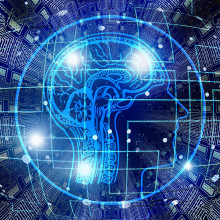
13:34 - Researching synaesthesia
Researching synaesthesia
with Duncan Carmichael, University of Edinburgh
Martha - Duncan Carmichael, a synaesthesia researcher at the University of Edinburgh is with us. How does synaesthesia work? What causes it? Is there any agreement on what colour 'A' and are the associations cultural?
Duncan - Hi, Martha. Well, we think synaesthesia is caused by a top of crosstalk between areas of the brain which wouldn't normally communicate with each other. So in most people, there's no real functional connection between areas of the brain that process different forms of sensory input, they don't activate each other. But in people with synaesthesia for example, there is clear evidence that these areas of the brain do communicate. So, if you take the example of James in the previous clip, when he reads or hears words, they activate not only the language part of the brain, but also the part of his brain which deals with taste. Whereas in people without synaesthesia, those parts of the brain are very separate and wouldn't activate each other at all, so it's this kind of cross activation between what a normally separate brain areas that seems to give rise to this synesthetic experience really.
Martha - And so, what's our current knowledge about the neural basis of synaesthesia?
Duncan - Well, evidence is starting to supports this idea of cross activation. There are some functional MRI studies that show this simultaneous activity does indeed occur actually. So, colour-letter synasthetes for example, when they read black and white letters, the colour regions of their brain become active. So in effect, they're experiencing colour without actually seeing it. And there is more recent work, which has looked at whether there are differences in the underlying neural structure of synesthetes brains and indeed, this appears to be the case. The areas which show this simultaneous functional connectivity, this cross activation. There's more white matter connectivity between those areas and synesthetes and so, we can almost say that synesthetes brains are wired up differently to non-synesthetes.
Martha - And is this a consistent phenomenon? Is it consistent within an individual and is there any consistency between individuals? For example, is a certain word associated with a certain taste or colour for example in different people or does each person have their own individual take on it?
Duncan - People often have their own individual takes. I mean, there is some kind of themes which do occur. I mean for example, 'A' often appears to be red. There is patterns which emerge, but often, people will have their own individual experiences. Often members of the same family who experience synaesthesia will disagree on the colours of letters they see. There is some kind of commonality but often, it's a very personal experience.
Martha - And is this something that varies with culture?
Duncan - I'm not so sure really. Someone did a study in Australia that took all the kind of books that had been published with different colours and looked to see whether there was themes that emerged, whether the books that people read at children kind of linked to their synesthetic experience, and I think that didn't turn out to be the case actually.
Martha - What can this tell us about the neuro-typical brain?
Duncan - Yeah, absolutely. I mean, even though synaesthesia is quite an unusual phenomenon, it can tell us quite a lot about how the normal brain processes information. I mean, the normal adult cortex is quite kind of specialised and quite modular, so the part of your brain that deals with vision for example only responds to input from the visual system or the part of your brain which deals with auditory input would only deal with input from the ears. But in synaesthesia, this doesn't appear to be the case. There's cross-talk between these different areas, and this may tell us quite a lot about how the brain actually develops. So, when you're born, these specialisations don't exist. So, what we think the study of synaesthesia can give us is a real insight into how this specialisation occurs because the synesthetic brain is obviously quite different and potentially develops along a different route. So, why do people with synaesthesia retain this capacity to have communication between different brain areas, which people without synaesthesia lose as they get older?
Martha - And so, what do we know about the inheritance and the genetics of this condition?
Duncan - People with synaesthesia typically, 40% of them have a first-degree relative with synaesthesia in their family. And there seems to be particular inheritance patterns. For example, mothers are quite likely to pass synaesthesia onto either sons or daughters, whereas fathers seem to pass it onto daughters only. One of the studies we're running in Edinburgh at the moment, really trying to identify genes that might be linked to the development of synaesthesia. Some work's been done in this area to date, but not very much. We've identified a few areas on chromosomes, so a few areas that contain hundreds and hundreds of genes that might be implicated in synaesthesia, but there's no specifically genes that have emerged that may be directly linked, and that's what we're trying to do with our current study, is recruit a lot of people with colour-grapheme synaesthesia, so people who see letters or numbers in colour and sample their DNA and see which genes might be specifically linked to the development of synaesthesia. So that's one thing we're trying to do at the moment. We suspect there's a collection of genes that are definitely involved in this process, but to date, nobody's had the ability to identify them. That's one thing we're trying to do with this particular study.
Martha - Duncan Carmichael at the University of Edinburgh.
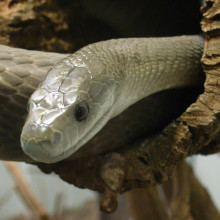
18:37 - Snake ache relief: powerful painkiller in venom
Snake ache relief: powerful painkiller in venom
Venom from the black mamba snake contains two powerful new pain-killing chemicals, French scientists have 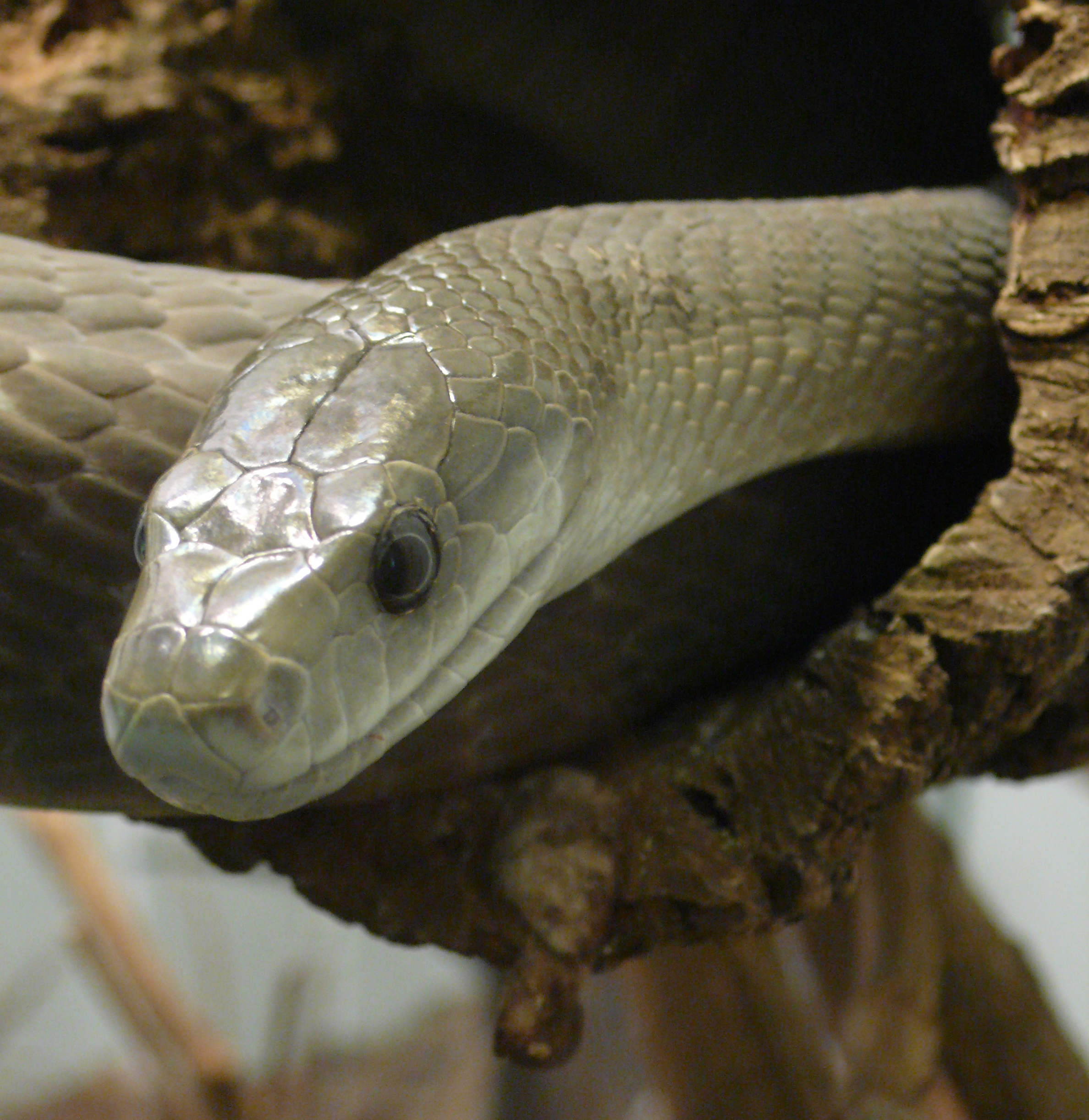 discovered.
discovered.
Venoms have evolved to be active against a wide repertoire of different prey and predator species, meaning that they contain a cocktail of nerve-targeting proteins with a range of effects.
Working with black mamba venom, CNRS scientist Sylvie Diochot and her colleagues separated these proteins into different fractions and tested them individually on cells in a culture dish.
What they were looking for were effects upon structures called ASICs or acid-sensing ion channels.
These are present in pain-sensing nerves and fire off barrages of electrical signals in response to the changes in local pH that accompany inflammation. This makes them a key player in pain signalling.
The French researchers found two proteins in the venom, which they've named mambalgin-1 and mambalgin-2, that appear to prevent the ASICs from responding to acid applied to their cultured cells.
To find out whether they could work as analgesics, the team then injected one of the mambalgin proteins into mice, either peripherally into the skin, or into the fluid around the spinal cord.
The result, published in Nature, was a reversible analgesic effect that kicked in within minutes and was as powerful as morphine but without any of the undesirable opioid side effects, like sedation or tolerance.
The tests also showed that the venom molecules were targeting different ASIC molecules in the skin compared with the spinal cord, revealing at least two new ways to control pain in future.

21:07 - Risky teen years due to ambiguity tolerance
Risky teen years due to ambiguity tolerance
The tendency to take more risks during adolescence is due to greater tolerance towards ambiguous situations rather than to actively seeking to take risks, finds
a new study in the journal PNAS.
![(c) By Jamie Adams from Hull, United Kingdom (Poker chips) [CC-BY-SA-2.0 (http://creativecommons.org/licenses/by-sa/2.0)], via Wikimedia Commons Gambling chips](/sites/default/files/media/Gambling_chips.jpg) Risky behaviours, such as smoking and having unprotected sex, have long been associated with the adolescent period of life. Agnieszka Tymula and her colleagues at New York University wanted to know what is the root of in thrill-seeking behaviour in adolescents.
Risky behaviours, such as smoking and having unprotected sex, have long been associated with the adolescent period of life. Agnieszka Tymula and her colleagues at New York University wanted to know what is the root of in thrill-seeking behaviour in adolescents.
The New York team's experiments aimed to distinguish those who had a tendency to take more risks when gambling from those who didn't actively seek out risks but simply weren't fazed by a lack of information about a bet. Adolescents aged 12-17 and adults aged 30-50 were given a choice: to take $5 or to take a gamble where they could either win $50 or nothing, and subjects knew the exact odds involved in this bet.
Surprisingly, this and a series of similar offers ranging in the value of prizes showed that adolescents were much less likely than adults to take a risk for more money when the probability of success was known.
So why do adolescents engage in risky behaviour generally if they tend to avoid simple risks like these? Another experiment tested how sensitive adolescents and adults are to a lack of information about a gamble.
An ambiguous situation was set up with 100 red and blue poker chips in a lottery bag. The subject was told there were 25 red chips and 25 blue chips, but wasn't told how many of the remaining 50 were red or blue. If the subject picked the winning colour they would receive $20, but they didn't know prior to picking a chip which colour was the winning one for that trial. If they picked the wrong colour chip they would win nothing. Alternatively, they could choose not to play the lottery and instead take a guaranteed $5.
This means that for each trial the subject didn't have enough information to judge whether they had a greater or lesser chance than 50% of winning $20 in the lottery. This and a range of more or less ambiguous lotteries showed that only the adolescents behaved as though this was the case. The adults were distracted by the ambiguity and tended to make choices that were either overly pessimistic or optimistic of their chances of success.
Although this can't explain the whole story of adolescents' typically risky behaviour, it can help understand why adolescents seem to put themselves at risk despite being 'safer' gamblers than adults. Adolescents simply seem to be more willing to engage in activities when they don't know the likelihood of something turning out very well or very badly.
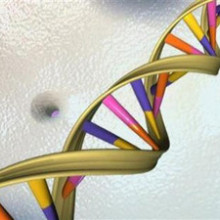
23:30 - Whole genome disease screen - in under 50 hours - for newborn babies
Whole genome disease screen - in under 50 hours - for newborn babies
with Dr Stephen Kingsmore, Children’s Mercy Hospital in Kansas City
Chris - A new diagnostic test for new-born babies has been developed. It can screen for more than 3,500 genetic disorders within 50 hours, a very big improvement when you compare it with the currently-used methods. 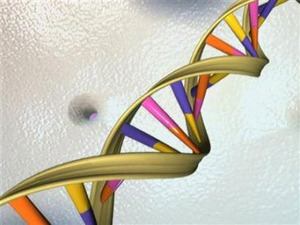 Three per cent of newborns will have a genetic disorder and for some of these problems, the earlier that you start treating, the better the overall prognosis. With us to discuss this new test, which has been developed with the help of a company called "Illumina" - who have their European base in Essex - is Dr. Stephen Kingsmore. He's from the Children's Mercy Hospital in Kansas City and he's with us. Hello, Stephen.
Three per cent of newborns will have a genetic disorder and for some of these problems, the earlier that you start treating, the better the overall prognosis. With us to discuss this new test, which has been developed with the help of a company called "Illumina" - who have their European base in Essex - is Dr. Stephen Kingsmore. He's from the Children's Mercy Hospital in Kansas City and he's with us. Hello, Stephen.
Stephen - Hello.
Chris - So, what was the problem you're actually trying to solve with this?
Stephen - Let me give you an example before and after this test. So baby Stephanie was born in March 2012. She was a bit small at first, but pretty normal. However, 1 hour after she was born, she started to have seizures, epileptic fits and so she was transferred to an intensive care unit. And for 5 weeks, pretty much everything was attempted to stop these seizures, but without any effect. In that period of time, her parents had tremendous anguish. They had feelings of guilt and they had false hope that their baby is going to be saved; and all the while, nobody could tell them exactly what was going on. Now eventually, after 5 weeks, the doctors got together with the parents. They said, "We think this is hopeless." And the parents after some thought decided to withdraw support and baby Stephanie died that day. Now let's contrast that with after the test. So now, let's say baby Stephanie was going to be born in December of this year, she'd have exactly the same first day of life, but 2 days later, two days later she would've received, or her parents would've received, a definitive diagnosis that she had a mutation in a gene called BRAT1 and that, tragically, there was no way to save her life. What that would have meant for her parents is that, first of all, they wouldn't have been guilty. This was not because mum had a glass of wine during pregnancy. They would've known that it was hopeless. It would've had a clear. It would've known their risk of having another baby with the same thing and they would've been able to bond with their baby with the baby out of the intensive care unit, be able to say their goodbyes, bring in their pastor or priest, bring in their grandparents, and there would've been a sense of parental empowerment, and proper goodbyes. So that's the difference before and after this test was developed.
Chris - Sounds wonderful. How does it actually work?
Stephen - Well, it's pretty simple. We decode the entire human genome using a very speedy sequencer. So that's 3.1 billion letters - that's the equivalent of a manuscript 300 feet high - and we do that in each baby. We do that in a day and then it takes another day for us to take that information, process it and link it to whether or not the baby had one of the 3,500 genetic diseases.
Chris - First of all, the human genome project, which sequenced one human, took years to do it and you're doing that in a day. How on Earth are you doing that?
Stephen - This was a technology that was developed at Oxford University about almost a decade ago, but it's been getting better and better. And we're at the point now where we can decode a baby's entire genome in roughly a day. I mean, the scale has gone remarkably so that we have, literally, billions of chemical reactions occurring that we can monitor in real time and churn out hundreds of billions of very short fragments of the human genome code, and then we put these together to get the whole piece. It's like making a jigsaw puzzle with, say, 600 billion pieces.
Chris - But how do you know which of the changes in the DNA are the crucial ones that are giving that child its problem?
Stephen - It's been a huge problem, because only a tiny fraction of doctors, paediatric geneticists, actually know which test to order. There are 3500 to choose from and most physicians wouldn't have heard of most of these diseases. And so, we built some software that allows a regular paediatrician to plug in what's going on in the baby. In Stephanie, she was small and she was having seizures. So the doctor clicks those two boxes and a computer program matches that information to just the points in the genome where there are 89 genes that can cause this in a baby. And in that way, instead of having to scour the whole genome, we're able to focus in on the specific areas where, if there is a genetic cause, that's where it would be pinpointed.
Chris - And can it learn to recognise new disorders as more discovered because the power of this is obviously the rapid diagnosis. The downside is that it only answers the question you ask it, 'has the child got one of these conditions we know about'?
Stephen - That's a good question, and I don't have an easy answer; but if you look at the situation today where it takes 2 months to look at a single gene, a single point in the genome for a single disease, and you compare that with the ability in 2 days to look at 3,500, this is still a phenomenal advance. And building it out so that it sort of self-learns is definitely feasible, but not straightforward.
Chris - And is this widely available? Will the average hospital, maternity or maybe specialist unit have this technology available to it in the near future?
Stephen - Well, I should say that our paper is a proof of concept. We only looked at about half a dozen babies and so, this really is just a first report. A lot more needs to be done to understand what are the right places to put this in intensive care units. It's expensive. It costs over 8,000 pounds to test a single baby and the sort of infrastructure is not something you find commonly in hospitals. But we hope by the end of this year - so Illumina are shipping us our new genome analyser - but the work we did in the manuscript, we actually had to get the DNA from each baby and then courier it across the Atlantic to Essex, where the DNA sequence was generated, and then they loaded that on a hard drive and shipped it back across the Atlantic to Kansas City where we crunched the information. So, our goal, by December, is to have our own instrument in our own hospital and start to build experience. We really think that maybe next year, it will be possible for some places in the United States, and probably also in Great Britain, to be referral centres. You don't necessarily have to have the baby in your intensive care unit. You can certainly ship the DNA to a central location where this service could be offered.
Chris - Super! Well, thank you for joining us to tell us about it, Stephen. It sounds very exciting. That was Dr. Stephen Kingsmore. He's from the Children's Mercy Hospital in Kansas City and he published that research this week in the journal Science Translational Medicine.
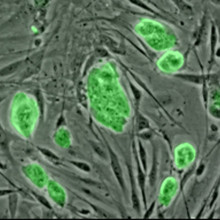
30:44 - Direct conversion of body cells to brain cells
Direct conversion of body cells to brain cells
A stem cell breakthrough has shown that neurons can be generated directly from body cells.
Cells involved in blood vessel maintenance called pericytes have been converted into neurons by Marisa Karow and her colleagues at the Ludwig-Maximillians University in Munich.
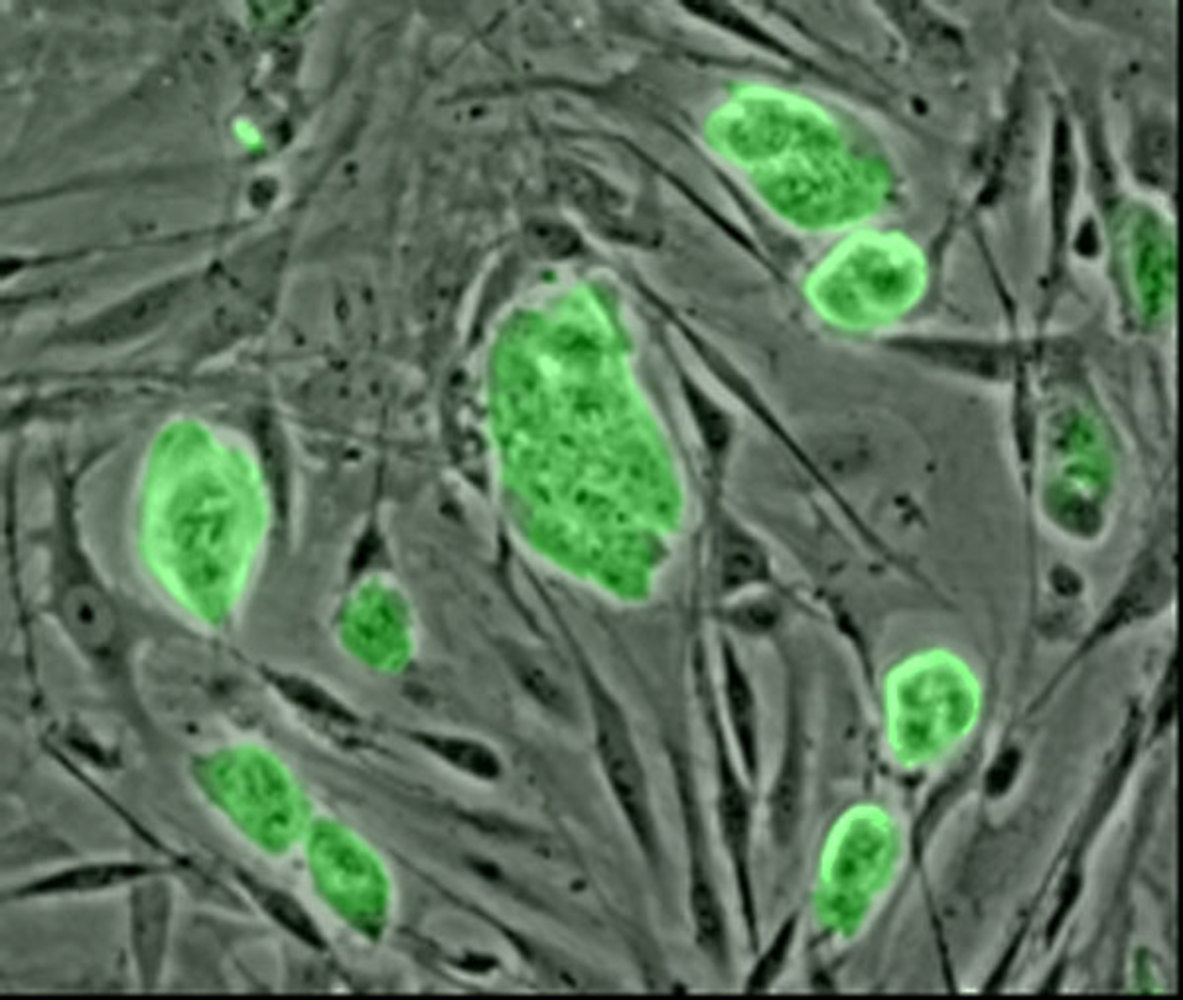 Previous studies have shown that conversion from bodily cells to neural cells is possible by reprogramming the cell back to an earlier stage of development and then guiding it down another developmental route towards a different cell type. Converting a cell directly from one type to another without these intermediate stages is a significant step forward towards potential therapies for diseases in which neurons become damaged, such as Alzheimer's and Huntingdon's.
Previous studies have shown that conversion from bodily cells to neural cells is possible by reprogramming the cell back to an earlier stage of development and then guiding it down another developmental route towards a different cell type. Converting a cell directly from one type to another without these intermediate stages is a significant step forward towards potential therapies for diseases in which neurons become damaged, such as Alzheimer's and Huntingdon's.
The Munich team used a virus to introduce two new genes into human pericytes. These encoded two proteins called Mash1 and Sox2, which influence the transcription of a number of other genes. When Mash1 and Sox2 were introduced together they caused cells to produce the protein βIII-tubulin which is a key protein in neurons. The cells became similar to neurons in shape and structure.
The transformed cells didn't just look like neurons, they acted like them too. When the team looked at the electrical activity of the transformed cells they found that 71% could perform basic electrical signalling. Although far from perfect, the cells could be recognised and have successful interactions with other ordinary neurons when grown together in a culture.
These developments advance the possibility and practicality of effective stem cell therapies for a range of neurodegenerative diseases. A way to introduce genes like Mash1 and Sox2 into the brain in a safe and convenient way needs to be found if therapies like this are to be developed.
When these barriers have been overcome, Karow and her colleagues argue in
their paper published in the journal Cell Stem Cell, stem cell therapies will be able to effectively reprogramme damaged brains.
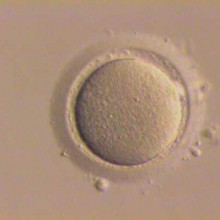
32:38 - Eggs, ovaries and offspring from stem cells
Eggs, ovaries and offspring from stem cells
Eggs capable of being fertilised and turning into healthy mice that are themselves fertile have been produced from stem cells by 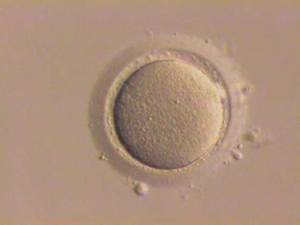 scientists in Japan.
scientists in Japan.
Writing in Science, Mitinori Saitou and his team at Kyoto University took embryonic stem cells and expressed two genes - prdm-1 and Dppa3 - which are normally active in cells destined to become the future ovarian tissue in a developing mouse. These were then mixed with non-egg cells that play a supporting role in the normal ovary.
The resulting "reconstituted ovary" was then implanted into recipient mice to allow the donor ovarian tissue to grow.
By six days, the implanted tissue contained cells with the same genetic, epigenetic and biochemical characteristics that would be expected in an ovary developing in a normal mid-term mouse foetus.
To test their function, the team then harvested the nascent eggs from the reconstituted ovaries one month later and fertilised them with sperm in the dish.
A number of embryos began to develop which were then implanted into surrogate mouse mothers where a small number of them yielded healthy pups that were themselves fertile, proving that the technique can work.
But the success rate - at 4% - was very low, probably because, the team found, many of the resulting embryos produced when the reconstituted eggs were fertilised ended up with an extra set of chromosomes, rendering them inviable. Why, the researchers still need to find out.
But this result, and the fact that they were also able to produce new eggs using another source of cells called iPSCs (induced pluripotent stem cells), which can be made from mature adult cells, is a major step forward, both therapeutically and scientifically. Apart from revealing an approach for making replacement eggs, it also provides a new way to study how the process of egg cell development takes place, and the genetic and epigenetic changes occur around fertilisation.

35:53 - Planet Earth - Prion sea birds
Planet Earth - Prion sea birds
with James Grecian, University of St. Andrews
Climate change could be altering the migration patterns of seabirds, and a team, led by the University of Glasgow, is studying one seabird in particular. They’re called prions – a type of petrel, whose beaks filter food from the sea. They’re especially fond of tiny crustaceans known as copepods. Last year over two hundred thousand prions were discovered dead or dying on a New Zealand shore after a major storm. But the species’ decline has also been linked to failing food supplies resulting from changes in the climate. Planet Earth podcast presenter Sue Nelson went to meet Dr. James Grecian, one of the researchers working on the project, to find out more about these seabirds...
James - Prions are small seabirds, about the same size as a puffin. They’ve got a similar wingspan, but much lighter, they’re only a couple of hundred grams. SO very, very small birds and they breed in large colonies, sometimes up to 2 million pairs around the Southern ocean, in places like New Zealand, the Falkland islands. But, because these birds are so abundant, they’re really major consumers in ecosystems. And so it’s really important that if these are birds that are being impacted by climate change, then there’s a whole range of other species that could be impacted by climate change. I mean, if copepods are moving and birds can’t follow them, maybe fish can’t too and that has implications for global fish stocks.
Sue - How has this sort of, abundance of copepods, affected these particular birds?
James - Plankton species are very, very susceptible to changes in temperature, so as the oceans warm they’ll move towards the Poles. For species that target copepods, this could be a massive change. So, if your main prey species is moving, you’re going to have to adapt and change to try and follow them. And what I’m trying to work out is whether or not they can.
Sue - So how do you do that?
James - Firstly, we can look at stable isotope - non-radioactive isotopes in your body that you absorb as you’re feeding. And they are relatively predictable. And so we can use that as a guide to try and understand where prions are. So if we can sample prion feathers, we can look at the isotopes in those feathers and work out what the prions have been eating. We know it’s copepods, we can try and work out where those copepods were and therefore where the prions were when they were eating them.
Sue - I notice you’ve got something that looks remarkably like some feathers in your pocket there.
James - Yeah, so I’ve got a few samples of feathers here from a bird that was sampled in Gough island, in the middle of the Southern Atlantic. And these are feathers sampled from a bird that was killed by skewers and they kill prions and eat prions. And so round colonies in the Southern ocean, you find big piles of dead prions and it’s a really, really good resource for us, we can go along, we can pick up and we can sample lots of birds that we know were killed on that colony, so we know were probably from that colony. And if we then use those feathers and analyse those feathers, we can get an idea of where that bird was before it was killed. This figure I’ve got in my hand here is dark round the outside because it’s one of the outer primary feathers. And so this was probably grown in the centre of the wintering grounds. We believe that primary molt, so the molt of the main flight feathers in a bird starts with the innermost primary and works towards the outermost primary. And that starts as the leave the breeding colony. So if we sample feathers from the outside of the wing, those are the feathers that are form the wintering grounds and those will give us an idea of what the bird was feeding on.
Sue - So what sort of chemicals or what signature in effect, are you trying to get from a feather like this one here?
James - We put it through a mass spectrometer, working with the Scottish Universities Environmental Research Centre, in East Kilbride. And the two elements that we’re mainly interested in are carbon and nitrogen. We’re interested in different isotopes of carbon and nitrogen, so we’re interested in heavy carbon and heavy nitrogen – Carbon-13 and Nitrogen-15. And they will accumulate in body tissues. So, for example in nitrogen, the heavy nitrogen is much harder to metabolise than light nitrogen and so as you’re eating things, your body will withhold, will store if you like, the heavy nitrogen because it’s much easier to get rid of the lighter ones because it’s easier to metabolise. And so for animals that forage very, very high up the food chain, there will have been this build-up in nitrogen, or heavy nitrogen in their tissues. And so, we can look at the ratio of nitrogen, of heavy nitrogen in their tissues and that will give us some idea of where the bird’s been foraging.
Sue - And then you can tell how far they’re moving as a result of climate change moving their source of food.
James - Exactly. The other isotope we’re interested in is carbon and carbon is much better as an idea of spatial differences because it’s due to baseline productivity. So regions of the ocean that are very productive will have different carbon signatures to areas of the ocean that are less productive. And, it’s actually quite nice in that, in the Southern Ocean because of the way the ocean fronts, the sub-Tropical fronts and Polar fronts build up, there’s actually a relatively predictable gradient in carbon. So, if we look at the carbon isotopes, heavy carbon isotopes, in our feathers, we can, to an extent, within various confidences, get an idea of where, along the Southern ocean, that bird was wintering. So what we want to do is we want to try and get a baseline, to try and look at what the isotopes mean in space, and we can do that through tracking data. We can try and correlate the two to see what isotopes are associated with what areas in the wintering grounds. One of the key things with using the isotope data is that we’ve got museum specimens from as early as 1871. So we can compare the isotopes in feathers today, in 2012, with birds that were killed on colonies 140 years ago.
Sue - And you could match that up with climate data.
James - Hopefully that’s exactly what we’re going to try and do. That’ll give us some idea of how the birds may have moved in the wintering areas that they’re using, which could well be due to climatic change.
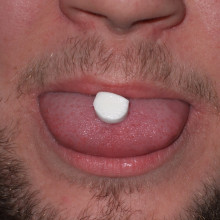
41:28 - Restoring taste to chewed chewing gum
Restoring taste to chewed chewing gum
with Barry Smith, University of London
Chris - Now we're returning to our theme this week, which is Tricks of the Mind and how the brain works. In a minute we'll find out why names are so easy to forget. And we'll also find out how the placebo effect comes about. But before that we'll return to Barry Smith, who's with us for this week's program. And, you've got another trick for us.
Barry - Yes. So Martha's been chewing some minty chewing gum and I hope by now the mintiness has disappeared.
Martha - Yes and it's going a bit cardboardy and generally not very nice.
Barry - OK. So now what I'm going to do is I'm going to ask you to take it out of your mouth and roll it in this little mound of icing sugar that I've got in front of you and if you just pop that back and have a chew on it.
Martha - Urgh, choking on some icing sugar.
Barry - Tell me how it tastes now. Just keep chewing away for a moment or two. So what we're really investigating is the way that one sense has an impact on another. So, here we're talking about how taste might affect smell.
Martha - Mmm...Yeah, so it's definitely tasting newer again and yeah, the mintiness is coming back.
Barry - So the mintiness has come back and that's amazing because there is no mint in icing suger. So that's a strange effect. What you're getting is the fact that when you combine the sugar with the odour in your mouth, you get something super-additive that's more than the sum of the parts. You're not getting them both together, you're getting the sugar boosting your ability to detect mint and the mint seems to resume its presence.
Chris - Does this manifest anywhere else in the food industry? Do other manufacturers use this effect to enhance other flavours?
Barry - Yes, and they do it often with smell to taste going in the other direction. So when you smell vanilla, people often say it smells sweet. And we know that if you're tasting a liquid, say, and get a vanilla aroma with it, it will taste sweeter. And that's, in fact why vanilla ice cream is much better to make than anything else, because you can use less sugar to produce it because you've got the vanilla smell to give us this sweet experience.
Chris - You can legitimately argue it's a diet ice cream.
Barry - It's a diet ice cream!
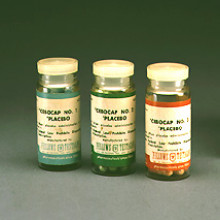
43:37 - How does the placebo effect work?
How does the placebo effect work?
with Karen Jensen, Harvard University; John Forrester, Cambridge University; Shane Glacken, University of Exeter
Martha:: The placebo effect is a reported improvement in a patient's condition in response to their own expectation that a drug or treatment will make them better. 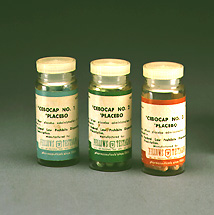 Even giving a person a pill containing sugar and nothing else can still produce powerful painkilling effects if the person believes it's an analgesic. So, what's going on in the brain to make this happen? I began by speaking with Harvard based research fellow in psychiatry Karen Jensen.
Even giving a person a pill containing sugar and nothing else can still produce powerful painkilling effects if the person believes it's an analgesic. So, what's going on in the brain to make this happen? I began by speaking with Harvard based research fellow in psychiatry Karen Jensen.
Karen:: The first study that provided the biological evidence for the placebo effect was done in the 70s by a researcher called Levine and he was able to show that he could block the placebo effect by giving people an antagonist for opioids.
Martha:: Opioid antagonists prevent opioid chemicals - for example, painkilling drugs like codeine and morphine - from binding to their receptors in the brain. This acts to lower the sensation of pain in the body. Levine showed that the placebo effect was also reduced when these opioid receptors were blocked, meaning that the analgesic placebo effect involves these chemical receptors just as much as chemical painkillers do. There are, however, some interesting differences in the brain during placebo and active analgesia treatments. Brain imaging studies by Jensen and her colleagues showed that the prefrontal cortex, the outermost layer of the front part of the brain, seems to play a stronger role in placebo treatments...
Karen:: When you compare a real drug to placebo, very similar networks in the brain are activated, but the prefrontal cortex is uniquely activated during placebo analgesia as compared to morphine for example. This might represent "expectancy" effects. So, if there's an expectancy for pain relief, that expectation might be processed there in the lateral prefrontal cortex.
Martha:: But even knowing this, the first cause of the placebo effect, the thing that initially gives rise to the stimulation of those brain regions, still isn't clear. The full mechanism of the placebo effect between the first expectation of getting better and actually getting better isn't scientifically understood. I spoke to John Forrester at the History and Philosophy of Science Department at the University of Cambridge about other factors involved in the placebo effect.
John:: One of the peculiar things about this is physical evidence about placebo effect it's in an extraordinary range of variation - between 18% to 75% - partly dependent on condition, but it seems to be dependent on geographical location. Now, this complicates the study of the placebo effect, but, in a sense, it's what you might expect, if it's not just neurochemical, it's not just psychological, but in some sense it's a "social" condition. There's a complicated social production of a placebo effect, which is the next obvious thing to say: that placebo effect really has to be the relationship, not only of the patient to the doctor or the patient to the doctor's coat, to the kind of equipment the doctor has in the office, to the kind of hospital that they're entering into, to the reputation of the hospital. That is going to be part of what we call the placebo effect; it's going to be bound up in it. You don't want to restrict yourself immediately to saying it's neuroscientific, or psychological, or sociological, because it's a very complicated creature.
Martha:: So, social and cultural factors, for example, public attitudes towards the medical profession in a certain geographical area influence the patient's expectations of what will happen to them. In turn, this expectation translates into a real change in symptoms. This means people's values, beliefs, and prejudices can partly determine the outcome of their condition. If the placebo effect is so prevalent and so powerful, is this something doctors can exploit to benefit their patients? If a sugar pill is much cheaper than an active painkiller and just as effective, and may also avoid some nasty side effects, what's stopping the doctor using the placebo? One of the main problems is the element of deception. Lying to patients is obviously a bad thing and leads to endless legal battles in public mistrust in the medical profession. But can the power of the placebo effect be used in an honest and non-deceptive way? Medical philosopher Shane Glacken at the University of Exeter believes so.
Shane:: So, usually, the formulation a doctor would use in recommending a placebo treatment is something like, "Well, I'm going to give you these pills, I'm going to give you this shot. We don't really know how exactly it works, but it's been very effective in relieving pain, or for people in your situation, and I'm confident that it's going to be effective in your case." Now, it doesn't seem to me that anything relevant is being left out there.
Martha:: And, to add one last twist to the story, placebo treatments can even have an effect when the patient knows all about them.
Shane:: Interestingly enough, there are at least 2 studies that show placebos tend to work even when the patient knows that there's a placebo. I think there's a Parc and Covi study from the '60s, there's a more recent one done at the Harvard Medical School, you can tell people, "This has no pharmacological effects. It's just a sugar pill, but it will make you feel better," and it does tend to work!
Martha:: So, a doctor can be completely open about placebos and they'll still do the trick, although they tend to be less effective if given this way. With an increasing knowledge of the neuroscience behind the placebo effect to back up subjective reports, and with an appreciation of the social and cultural influences on this phenomenon, perhaps an ethically sound way of using placebo treatments more widely in clinical practice isn't such a stretch of the imagination.

Why do tastes change, so we like things we previously abhorred?
Barry:: I think it's banned to have it indoors. This is a very, very stinky fruit, but of course, once you put it in your mouth as we talked about earlier, the taste is actually very nice because the brain is handling the aroma coming up from the mouth to the nose differently and projecting to a slightly different cortical regions than it does when you smell it from the outside. Now of course, what the brain does is it learns. There's an association between the prediction of that lovely reward of flavour and eventually, tunes out to find it so disgusting to smell this funny smell. It's leading you to the right thing, but you're going to get the right reward.
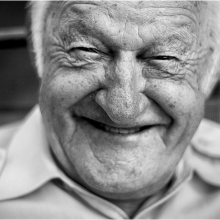
Do tastes change as we age?
Barry - So, our taste buds don't really change, although the smell diminishes as we get older. It actually can be improved right up until 50, 60, and then it drops right off. But think of one reason why children don't like bitter taste, green vegetables, and it's very difficult to get them to eat it. But eventually, when they become of a certain age, they integrate the taste, touch, and smell, so they get a combined flavour rather than a single blast of bitterness, and that's what allows them, I think, to eat vegetables eventually.
Chris - Oh, that's fascinating. So, the kids when they're experiencing taste are literally experiencing it one dimensionally - the taste or the smell.
Barry - Their getting a taste and the smell, whereas we're actually getting something that combines the two.
Chris - The whole experience.

Can you train yourself to stop synaesthesia?
Duncan:: That's an interesting point. I think it's definitely possible to kind of modify your experiences. There's anecdotal evidence to suggest that this kind of strength of the synaesthetic experience does fade over time. It's commonly thought to be a kind of developmental thing. So, there is evidence that it changes over the course of a lifespan, but I think it is possible to kind of actively modify what you do experience; i mean the brain is incredibly plastic. There is an anecdotal report from a synaesthete who used mathematics as part of his job and everyday life, and he found that having coloured numbers was a very good benefit for his work whereas coloured letters didn't really seem to kind of lend any advantage. And over the course of time, the strength of his associations with colour and letters tend to fade away. So, I think it is possible to modify experience. I'm not entirely sure if you could get rid of it entirely.
Barry:: There's some work coming out of Roi Cohen Kadosh's lab in Oxford suggesting that, under hypnosis, synaesthesia, or the experience of the extrasensory phenomenon, disappears. So, is it possible to induce it under hypnosis too? And we know that hypnosis is something that you're either susceptible to or not genetically. So, there is a limited class of people who could turn it off.
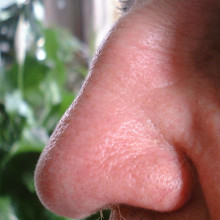
Does not having a sense of smell put someone at a disadvantage when tasting food?
Duncan - Yes, definitely arguing with a disadvantage. It means that things that have salt or sour flavours, or bitter flavours, you will be more sensitive to perhaps than she is and the other thing that's going to matter is that people who are used to having both, when they lose their sense of smell, they actually believe they can't taste anything. A good medic will test them - salt, sweet, sour, bitter - yes, you still got those, but if you're getting them by themselves without smell, then they'll be doing all of the work, so you'll want very tasty food.

Do psychedelic drugs generate synesthetic experiences?
Duncan - Well, we don't know exactly how that occurs, but we do know that it does occur. It also can occur through brain accident or injury as well. I think it's an unknown question. I mean, what we don't know is if it's the same mechanism or whether it's a completely different mechanism. What we do know is it can occur through taking LSD or 'acid' that people do indeed experience something very similar to synaesthesia.
Chris - So there you go, if you want to know what it's like, you have to take some LSD, but don't do that, not a good idea.
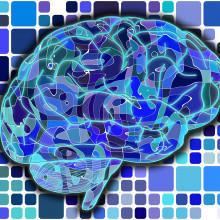
54:37 - Why do I have such a poor memory for names?
Why do I have such a poor memory for names?
We put this to Dr Dr Bernhard Staresina, from the MRC Brain Science and Cognition Unit in Cambridge...
Bernhard: My name is Dr Bernhard Staresina and I investigate the mechanisms of human memory at the MRC Cognition Brain Sciences Unit in Cambridge.
Names are quite arbitrary and abstract labels. So, it's very challenging to link a person and a name in any meaningful way. This is a problem because we know from research that new information is much better learned if it can be integrated into a pre-existing knowledge, also known as schema. For example, if you're an expert in wine and you're introduced to a new bottle of wine, it would be easier for you to remember say, the name and vintage of the wine than for a person who knows little about wines. And this is simply because you will automatically integrate a new wine into your internal wine database and make crosslinks to other wines you know.
This act of embedding information to an existing schema is called semantic elaboration and that's known to greatly boost our ability to remember new information.
Hannah:: And where is this semantic elaboration happening? The prefrontal cortex just behind your forehead acts as director, drawing on information from across your brain. So, can we use this knowledge to help us remember somebody's name. Back to Bernhard.
Bernhard: Now with names, given that they are arbitrary labels, it's much more difficult to use the semantic elaboration. That said, one effective strategy to make names more memorable is to try somehow make sense of them. For instance, if you're at a party and the first person you meet is called Andrew, you could mentally emphasise the fact that he was the very first person you met at the party then make a crosslink to the alphabet or the first entries letter 'A'. You'll see that this very act of semantic elaboration will make Andrew's name more memorable to you. It's just like tying a knot in your handkerchief.
Hannah: There is also the commonly used trick of conjuring up an image of the person you've just met in order to remember their name. Again, activating the prefrontal cortex and hippocampus using semantic elaboration to get the memory to stick.
So, for example, when I first met Chris, I imagined him naked, holding a big microphone in one hand, and on the other hand a blacksmith's anvil. I brand-stamped his name across his naked chest and his name stuck.
But why is it that we need to come up with such devices in order to remember what people are called? As well as names being arbitrary, when we first meet someone, we're busily engaged in social etiquette and so sometimes, that's why it's tricky to concurrently take in the name and store it to memory...










Comments
Add a comment